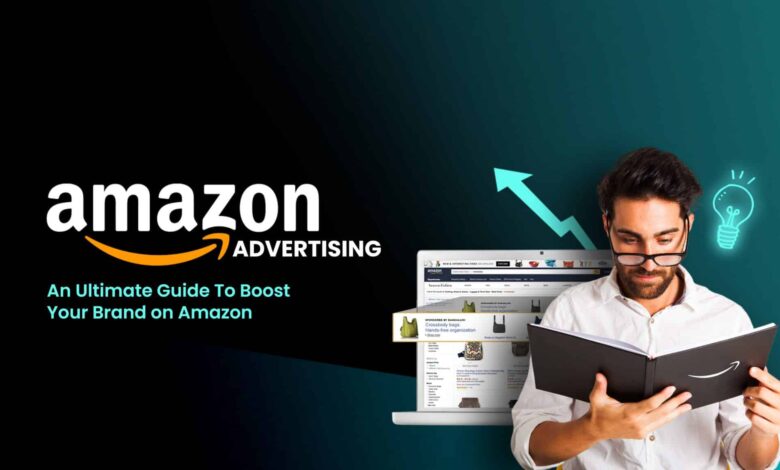A Comprehensive Guide to Amazon Ads: How to Leverage the Power of Amazon’s Advertising Platform

In today’s rapidly evolving e-commerce landscape, businesses are constantly seeking new ways to enhance their visibility and drive sales. One of the most powerful tools for achieving this goal is Amazon Ads, an advertising platform that allows sellers and brands to reach millions of potential customers within the Amazon ecosystem. With the right approach, Amazon Ads can drive significant returns on investment (ROI) and help businesses thrive in the competitive e-commerce space. In this article, we will explore Amazon Ads in detail, providing you with the knowledge to effectively leverage this powerful platform for your business.
What is Amazon Ads?

Amazon Ads is an advertising solution offered by Amazon that allows businesses to promote their products and brands to customers across Amazon’s platform. With a diverse range of advertising options, Amazon Ads provides businesses with the tools they need to increase product visibility, drive traffic, and ultimately, increase sales. The platform offers various ad types, targeting options, and reporting features that allow advertisers to tailor their campaigns to suit their specific objectives.
Why Use Amazon Ads?
There are several reasons why Amazon Ads is an essential tool for businesses, particularly e-commerce sellers:
- Massive Audience Reach: Amazon is one of the world’s largest online marketplaces, with millions of customers shopping for a wide variety of products every day. By advertising on Amazon, businesses can access this massive audience, increasing their chances of reaching potential customers who are actively looking for products.
- High Purchase Intent: Amazon shoppers typically have higher purchase intent compared to visitors on other platforms. Since people come to Amazon to buy products, your ads are more likely to convert into sales. This makes Amazon Ads an incredibly effective advertising tool.
- Advanced Targeting: Amazon Ads provides sophisticated targeting options, including keyword targeting, product targeting, and audience targeting. This allows businesses to reach highly relevant customers who are most likely to purchase their products.
- Measurable Results: Amazon Ads offers detailed performance metrics that allow businesses to measure the success of their campaigns. From impressions to conversions and return on ad spend (ROAS), you can track key performance indicators (KPIs) and adjust your strategy accordingly.
- Cost-Effective: Compared to traditional advertising channels, Amazon Ads offers a relatively low cost per click (CPC) model, making it an affordable option for businesses of all sizes. Additionally, you can set budgets and bids to ensure that you’re spending in line with your marketing goals.
Types of Amazon Ads
Amazon Ads offers a variety of ad types that cater to different business needs. The main ad types include:

- Sponsored Products: Sponsored Products are the most popular ad format on Amazon. These ads promote individual products within the search results and product detail pages. They are targeted based on keywords and appear in highly visible locations, increasing the likelihood of customer engagement.
- Keyword Targeting: You can target your ads to specific keywords that shoppers are searching for. This helps you reach customers who are actively searching for products like yours.
- Product Targeting: You can also target specific products or product categories, allowing you to reach customers who are browsing similar or complementary items.
- Sponsored Brands: Sponsored Brands (formerly known as Headline Search Ads) allow you to promote your brand and product portfolio at the top of search results. These ads feature a custom headline, logo, and multiple products. Sponsored Brands are ideal for businesses that want to increase brand awareness and showcase a range of products.
- Brand Awareness: Sponsored Brands are perfect for driving awareness of your brand, especially if you have multiple products that you want to promote.
- Customizable Creatives: You can create personalized ad creatives, including brand logos and banners, to make your ads stand out.
- Sponsored Display: Sponsored Display ads allow you to target shoppers both on and off Amazon. These ads can appear on product detail pages, customer review pages, and other Amazon sites, as well as on third-party websites and apps through Amazon’s Display Network.
- Retargeting: Sponsored Display is particularly effective for retargeting shoppers who have previously viewed your product but haven’t made a purchase. These ads help remind potential customers about your product.
- Interest Targeting: You can also target shoppers based on their interests, helping you reach new customers who are likely to be interested in your products.
- Amazon DSP (Demand Side Platform): Amazon DSP is a more advanced advertising solution designed for large-scale advertisers. It enables businesses to programmatically buy display and video ads across Amazon’s ecosystem, as well as third-party websites and apps. DSP offers more extensive targeting and measurement capabilities compared to other Amazon ad types.
- Advanced Targeting: DSP allows you to target audiences based on shopping behaviors, demographics, and interests.
- Cross-Platform Reach: You can reach customers on Amazon, as well as external websites, making DSP a powerful tool for broadening your advertising reach.
- Amazon Video Ads: Video ads allow businesses to showcase their products through engaging video content. These ads can appear on Amazon’s product detail pages, search results, and across Amazon’s video ad placements.
- Increased Engagement: Video ads are highly engaging and can help increase customer interest in your products.
- Brand Storytelling: With video, you can effectively communicate your brand story and highlight the unique features of your products.
How to Set Up an Amazon Ads Campaign

Setting up an Amazon Ads campaign is relatively straightforward. Below is a step-by-step guide to getting started:
- Sign In to Seller Central or Amazon Advertising Console: If you’re a seller, log in to your Seller Central account. For vendors, use the Amazon Advertising Console. Both platforms provide access to the same advertising features.
- Choose Your Campaign Type: Select the type of ad you want to run (e.g., Sponsored Products, Sponsored Brands, Sponsored Display). Depending on your goals, you can choose the most appropriate ad format.
- Define Your Campaign Budget: Set your daily or lifetime budget. Amazon Ads operates on a cost-per-click (CPC) model, so you only pay when someone clicks on your ad. Setting a budget helps you control how much you spend.
- Target Your Audience: Choose your targeting options. For Sponsored Products, you can select keyword or product targeting. For Sponsored Brands, you can target specific products or product categories. Be sure to select the most relevant keywords or products to maximize your reach.
- Create Your Ad: Depending on the ad type, you will need to create your ad creatives. For Sponsored Products, this will include selecting the product(s) you want to advertise. For Sponsored Brands, you can upload your brand logo and create a custom headline.
- Launch Your Campaign: Once your campaign is set up, review all settings, and launch your ad. You can monitor its performance through the reporting dashboard to track key metrics and optimize your campaigns as needed.
Best Practices for Amazon Ads
To get the best results from Amazon Ads, consider the following best practices:

- Use High-Quality Product Listings: Ensure that your product listings are optimized with clear, high-quality images, compelling product descriptions, and relevant keywords. This helps improve the performance of your ads, as better listings lead to higher conversion rates.
- Optimize Keywords: For Sponsored Products, carefully research and choose the right keywords to target. Use both broad and specific keywords to reach a wider audience and improve ad relevance.
- Monitor Performance and Adjust: Regularly check your campaign performance metrics, such as CTR (click-through rate), ACOS (Advertising Cost of Sale), and ROAS. Use this data to make adjustments to your targeting, budget, and bids.
- Leverage Negative Keywords: Negative keywords help prevent your ads from showing up for irrelevant searches. By excluding keywords that are unlikely to convert, you can reduce wasted ad spend and improve your campaign efficiency.
- Test Different Ad Types: Experiment with different ad types to find the most effective format for your goals. Sponsored Brands may work best for brand awareness, while Sponsored Products may be more effective for driving direct sales.
- Use Amazon’s Automation Features: Amazon offers automated bidding and targeting options that can help optimize your campaigns based on performance. Take advantage of these features to simplify campaign management and improve results.
Measuring Success with Amazon Ads
The success of your Amazon Ads campaign can be measured through various metrics. Some of the key performance indicators (KPIs) to track include:
- Impressions: The number of times your ad is displayed to customers.
- Clicks: The number of times a customer clicks on your ad.
- CTR (Click-Through Rate): The percentage of impressions that resulted in a click.
- ACOS (Advertising Cost of Sale): The percentage of revenue spent on ads. Lower ACOS indicates a more cost-efficient campaign.
- ROAS (Return on Ad Spend): The revenue generated from your ads compared to your ad spend. Higher ROAS indicates a more profitable campaign.
By regularly reviewing these metrics, you can fine-tune your ad strategies to maximize results.
Conclusion
Amazon Ads provides businesses with an unparalleled opportunity to reach a massive audience, increase visibility, and drive sales. By understanding the different ad types, targeting options, and best practices, you can create highly effective campaigns that meet your business objectives. Whether you’re a small seller or a large brand, Amazon Ads can help you unlock the full potential of the Amazon marketplace. Start experimenting with Amazon Ads today, and watch your business grow!


